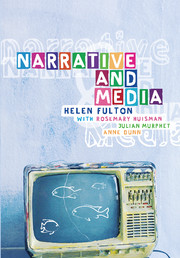Book contents
- Frontmatter
- Contents
- Figures and tables
- Contributors
- Acknowledgements
- 1 Introduction: the power of narrative
- Part 1 The basics of narrative theory
- 2 Narrative concepts
- 3 From structuralism to post-structuralism
- Part 2 Film as narrative and visual mode
- Part 3 Television: narratives and ideology
- Part 4 Radio and print journalism
- Part 5 Popular print culture
- Glossary
- Bibliography
- Index
2 - Narrative concepts
Published online by Cambridge University Press: 05 June 2012
- Frontmatter
- Contents
- Figures and tables
- Contributors
- Acknowledgements
- 1 Introduction: the power of narrative
- Part 1 The basics of narrative theory
- 2 Narrative concepts
- 3 From structuralism to post-structuralism
- Part 2 Film as narrative and visual mode
- Part 3 Television: narratives and ideology
- Part 4 Radio and print journalism
- Part 5 Popular print culture
- Glossary
- Bibliography
- Index
Summary
Narrative is realised in many different media. In this book we look at narratives in film, in television, in radio and in various media of popular print culture. These could be called ‘mass media’ in that all are assumed to be shown or broadcast to a scattered and diverse audience.
I want to begin here, however, with a narrative in a very different medium: a handwritten letter from one person to another person. This is a much simpler textual situation than that of many of the media texts we will later consider, yet, in an introductory way, we can identify certain features of this letter and its relation to its social context as exemplifying more general ‘concepts of narrative’. In the comments following the letter, the concepts, when first mentioned, are in bold. In the latter part of this chapter and in the next, chapter 3, many of these concepts are more generally described (see also the glossary, at the end of the book).
Introducing some concepts of narrative
In 1830 Isabella Parry ‘went to live at Port Stephens on the edge of the settled areas north of Sydney’, capital of what was then the British colony of New South Wales. Isabella's husband Edward had been knighted for his involvement in Arctic exploration; now he was appointed Commissioner of the Australian Agricultural Company. Isabella's letters home have been preserved. On 19 December 1831 she wrote to her mother in England:
We have lately experienced another disadvantage of a newly cultivated country, and have witnessed what I have only heard of before, and read in Cooper's novels – I mean the burning of the woods, and it is, indeed, a fearful and extraordinary sight. […]
- Type
- Chapter
- Information
- Narrative and Media , pp. 11 - 27Publisher: Cambridge University PressPrint publication year: 2005



